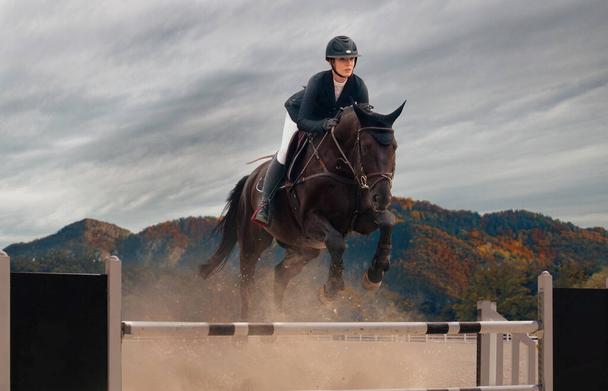This is a team concept, which refers to sports games using horses. When riding, the rider actively interacts with the movement of the horse. The horse is controlled by shifting the rider’s weight, squeezing the hips, and loosening or tightening the reins. The voice of the rider can also influence the movement of the horse, but not all equestrian sports allow this.
Types of equestrian sports
Equestrian sport is a collective concept, which refers to sports games using horses. When riding, the rider actively interacts with the movement of the horse.
The horse is controlled by shifting the rider’s weight, squeezing the hips, and loosening or tightening the reins. The voice of the rider can also influence the movement of the horse, but not all equestrian sports allow this.
Jumping
Overcoming obstacles, or, as it is often called, show jumping, is the most spectacular form of equestrian sport. For successful participation in it, a long and hard training of the athlete and the horse is required.

The rider must have courage and determination, fine calculation, high art of horse management, good general physical training. The horse requires a great repulsion force, high coordination of movements, the ability to maintain balance when flying over an obstacle and when landing.
There are many different types of show jumping. The most common competitions, during which the rider must, in a certain time, overcome all the obstacles on the show jumping field in the established sequence. The results of such competitions are evaluated by the number of penalty points.
In case of violations (refusal of the horse to overcome the obstacle – refusal, run-out, destruction of the obstacle, etc.), the rider is awarded penalty points – 4 sh.o. for every violation. For exceeding the time set for the passage of the route, the rider is also awarded penalty points – 1 sh.o. – for each overdue second.
The rider is excluded from the competition in the following cases: if the horse threw himself twice, if the rider fell on the route with or without a horse, if he violated the route, etc. According to the degree of difficulty, the competition is divided into classes: easy, medium, difficult and higher, which differ size and number of obstacles.
At the Olympic Games, World and European Championships, major competitions within the country, the programs include top-class competitions. In the Cup competition, each competitor completes the highest class route twice on the same horse in the first and second rounds (rounds).
Competitions are held up to the first mistake, on the power of the jump, on six gradually increasing obstacles, with overcoming obstacles in increasing difficulty, as well as relay races and single jumps over steep, high-altitude-latitudinal or latitude obstacles.
Dressage
Dressage is the most difficult and mysterious type of equestrian sport. It is known that by the 50s of our century, dressage, as a modern equestrian sport, had just begun to develop, and that it had undergone significant changes compared to the dressage that existed at the beginning of the century, in the 19th and even 18th centuries: complex elements disappeared , such as the Spanish step, school jumps and many others that can now only be seen in the Spanish, Viennese school or circus. Such exercises, on the one hand, served to prepare the horse for military service, and on the other hand, they were focused only on certain breeds of horses.

Finally, it is no secret to anyone that they were artificial and were achieved more through training than dressage. What is dressage today? The main thing is that dressage has become competitive. Now it’s getting harder and harder to succeed.
For dressage, such a thing has become fundamental: if earlier the one who rode just carefully and made fewer mistakes won, now there is no question of mistakes, fierce competition forces athletes to act on the verge of a foul: for example, if it is an added trot, then the horse rushes like that, which is about to break into a gallop. Who does not take risks does not drink champagne, and it is he who becomes the leader.
Triathlon
Equestrian Eventing includes competitions in overcoming obstacles, dressage, and, most importantly, cross country with overcoming indestructible barriers and water obstacles on rough terrain. Equestrian Eventing (short three-day competition) is a comprehensive test of horse and rider.
The form of these competitions goes back to the military art of riding. The cavalrymen demanded obedience from the horses, calmness in parades, courage, and the ability to behave on the battlefield. In addition, the horse must be able to perform his regular duties the next day.
A day or two of equestrian triathlon is taken up by dressage, the next day taking the test of speed and endurance races with the steeplechase as the final part of the competition that day. On the last day, the competitors must pass the show jumping area.
Eventing is the most complete, combined equestrian competition. It requires riders to have serious skills in all classic equestrian sports and a clear understanding of the skills of their horse, the degree of its preparation, obtained by reasonable and rational training.
